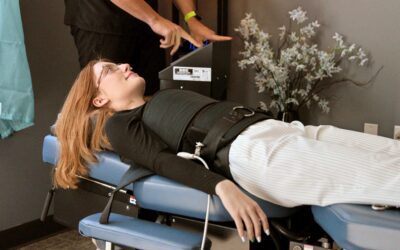From some people, headaches are a minor occasional nuisance, but for others they can be chronic and debilitating. Most headaches occur when nerves, muscles, and blood vessels are inflamed.
Other headaches can result from conditions, like a head or neck injury, or an illness. If you find you are suddenly in horrible pain, be sure to seek prompt medical attention to eliminate anything serious. If you are experiencing chronic headaches, your chiropractor can help with pain management and prevention.
If you feel that stress could be causing these headaches you may find a few minutes of daily journaling can help you express feeling overwhelmed. You can also talk with therapists online, download apps for meditation, and use videos for simple yoga poses.
The most common method to treat headaches is with over-the-counter pain relievers and hope that it works to relieve your pain.
These over-the-counter pain relievers may help some mild headaches, but leave chronic headache sufferers without any pain relief at all. Over-the-counter pain relievers are associated with liver and kidney damage along with other serious side effects if too many are taken for an extended period of time.
The good news is that chiropractic care offers many drug-free treatment options to relieve those debilitating headaches.
There are many different types of headaches, each with its own set of causes, symptoms, and treatments. Let’s take a closer look at the different types of headaches and how a chiropractor can help you feel better.
What Kind of Headaches Do You Experience?
Tension Headache – A tension headache is generally a diffuse, mild to moderate pain in your head that’s often described as feeling like a tight band around your head. A tension-type headache is the most common type of headache, and as the name suggests, this headache can result from physical and mental stress. Some people “hold” tension in their bodies and don’t breathe deeply.
Tension headaches can also be caused by poor posture, or muscle tension in the neck and shoulders. Chiropractic care can help to alleviate tension headaches by addressing the underlying musculoskeletal issues that are causing the tension.
Cluster Headaches – Cluster headaches usually occur in patterns or clusters. Bouts of frequent attacks, known as cluster periods, may last from weeks to months, usually followed by long periods of relief or remission. During remission, these attacks may stop for months or years. Pain is severe on one side of the head, accompanied by symptoms such as nasal discharge, or red or tearing eyes.
Cluster headaches typically come on suddenly and cause severe pain or burning around or on the eye. You might also experience a drooping eyelid and feel flushed.
Migraine Headaches – Migraine headaches can be of varying intensity, often accompanied by nausea and sensitivity to light and sound. Migraine headaches are sometimes preceded by warning symptoms.
Triggers can include hormonal changes, weather patterns, certain foods and drinks, stress, or exercise. Migraine headaches can cause throbbing in one particular area that can vary in intensity. Nausea and sensitivity to light and sound are also common symptoms.
With migraines you might experience an aura or reduced vision. Many women experience migraines during their menstrual cycle. This is a subtype of migraines called hormonal headaches.
Chiropractic care can help to alleviate migraines by addressing misalignments in the spine that can contribute to migraine symptoms.
Sinus Headaches – Allergies and colds can cause excessive mucus, post-nasal drip, and sinus headaches. These will give you pain near your cheekbones or forehead, often just below your eyebrows. You may also experience nausea and dizziness.
You can reduce pain with decongestants, antihistamines, and nasal sprays. Some people also use neti pots to rinse their nasal passages. Inhaling steam by standing above tea kettles, or taking hot showers, can help, too.
Rebound Headaches – Rebound headaches are caused by overuse of headache medications. Over time, taking too much medication can actually cause headaches to become more frequent and severe. Chiropractic care is a drug-free treatment that can relieve debilitating headaches without triggering rebound headaches.
Dehydration Headaches – Forgetting to drink water throughout the day can make any kind of headache more likely. Dehydration headaches cause a “squeezing” pain in either one spot or all over your head. You might also have other symptoms of dehydration like listlessness, dizziness, and nausea.
When people feel hungover after a night of heavy drinking, they are actually dehydrated. These headaches can also accompany heat illnesses that cause muscle cramps, rapid heart rate, and confusion. Rehydrate with water, electrolytes, and fruits and veggies to start feeling better.
How Can Your Chiropractor Treat Headaches and Migraines?
Several chiropractic treatments for headaches and migraines are available and can include the following:
Spinal Manipulation – Spinal manipulation relieves pressure on your joints, realigns your spine, improves blood flow, and helps relax tight muscles. Your chiropractor uses their hands or an activator to apply quick, forceful pressure to the vertebrae. Spinal manipulation is particularly helpful if nerve irritation triggers your migraines or cluster headaches. Manipulation relieves pressure on your nerves, easing your pain and reducing the frequency of your headaches.
Spinal Mobilization – Spinal mobilization involves gentle, hands-on pressure that stretches your spine, improves joint function, and helps ease tension in the muscles between the vertebrae. Since tense muscles can be an issue no matter what type of headache you experience, mobilization can be very effective.
Massage Therapy – Massage therapy is often included in treatment plans for headaches and migraines. The therapy loosens tight muscles, improves range of motion, increases blood flow, and may help reduce the frequency of your headaches. Regular massages also reduce stress, which can be a factor if you get tension headaches.
Flexion-Distraction Therapy – This therapy is performed on a segmented table that moves or drops as your chiropractor gently manipulates your vertebrae. Flexion-distraction therapy reduces stiffness, improves range of motion in your back and neck, and may even help decrease the number of headaches and migraines you get every month.
Your chiropractic treatment plan might include a few other types of therapy, including ice and heat therapy, ultrasound treatment, or electrotherapy. Improving your posture and strengthening the muscles that support your head and neck may also be helpful. Your chiropractor can recommend exercises, make suggestions that will help you improve your posture, and even provide advice about a healthy diet.
We’re Here To Help
Chiropractic care is a holistic approach to healthcare that focuses on the musculoskeletal system. Chiropractors use a variety of techniques to address misalignments in the spine and other musculoskeletal issues that can contribute to headache pain. By addressing the underlying issues that are causing the headaches, chiropractic care can help to alleviate pain and improve overall health and wellness.
If you suffer from headaches, it is important to seek the help of a qualified healthcare professional. A chiropractor can provide you with a thorough evaluation and create a customized treatment plan that is tailored to your individual needs. With chiropractic care, you can feel better and enjoy a better quality of life.
Are you tired of living with headaches or migraine pain? We can help relieve your symptoms naturally. Contact us to schedule an appointment.


